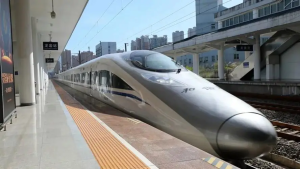China High-speed Trains (HSR)
China National Railway Group Co., LTD. (hereinafter referred to as the State Railway Group) learned that at 8:00 today, the first G871 Fuxing EMU train operated at a high standard of 350 km/h left Wuhan Station, which marks the completion of the safety standard demonstration line of the Wuhan to Guangzhou section of Beijing-Guangzhou high-speed Railway (hereinafter referred to as the Wuguang section of Beijing-Guangzhou high-speed Railway). The Beijing-Guangzhou high-speed Railway has realized the operation of Fuxing EMU trains at a high standard speed of 350 km/h, while the Beijing-Guangzhou high-speed Railway has put into use 24 sets of Fuxing intelligent EMU trains on the whole line, and the number of high-quality benchmark trains has increased to 99, the travel time along and around many cities has been further compressed, and the operation quality of Beijing-Guangzhou high-speed railway has been further improved, which will provide passengers with better travel experience.
The person in charge of the transport Department of the National Railway Group introduced that the Beijing-Guangzhou high-speed railway is one of the vertical main channels of the “eight vertical and eight horizontal” high-speed railway network, with a total length of 2298 kilometers, running through Beijing, Hebei, Henan, Hubei, Hunan and Guangdong six provinces and cities, connecting the core area of Beijing-Tianjin-Hebei coordinated development, the Central Plains city cluster, the middle reaches of the Yangtze River city cluster and the Guangdong-Hong Kong-Macao Greater Bay Area, and the trunk position is very important. After the Fuxing EMU trains are operated at a high speed of 350 kilometers per hour, the Beijing-Guangzhou high-speed railway will further strengthen connections between cities along the line, facilitate people’s travel, and inject new momentum into the implementation of major national strategies and regional economic and social development.
First, the expansion of transportation capacity has created conditions for the opening of additional high-speed trains.
The Beijing-Guangzhou high-speed railway realizes the high-standard operation of Fuxing EMU trains at 350 km/h, and the overall transportation capacity will be increased by 4.2%, which is equivalent to a maximum of 10.8 more Beijing-Guangzhou high-speed trains per day and an increase of 16,000 seats. At the same time, with the improvement of operating speed, the daily travel distance and turnover efficiency of EMU trains will be improved simultaneously. It provides space for scientific matching of station and line capacity resources and balanced transportation tasks of major stations in the hub, and also creates conditions for increasing the opening of high-speed trains in various places. From June 15, Zhengzhou to Wuhan, Wuhan to Changsha, Changsha to Hengyang and other busy sections opened 16, 16 and 14 more scheduled EMU trains; Each day, 13, 14, 36 and 37 EMU trains will be added to Wuhan, Hankou, Changsha South and Guangzhou Baiyun stations.

Second, travel time is compressed, and passengers travel more convenient.
As the longitudinal aorta of China’s high-speed rail network, Beijing-Guangzhou high-speed railway connects more than 10 high-speed railways such as Shitai, Xulan and Hukun, and realizes the high-standard operation of Fuxing EMU trains at 350 km/h on the whole line, the radiation effect is very significant, which will further reduce the travel time between cities along the line and surrounding cities. The Beijing-Guangzhou high-speed rail line can be reached in 7 hours 16 minutes from the west of Beijing, 3 hours 17 minutes from Wuhan, and 1 hour 59 minutes from Changsha south to Guangzhou, which is 22 minutes, 23 minutes and 19 minutes less than the current service. Through the Beijing-Guangzhou high-speed rail cross-line operation, the fastest travel time from Beijing West to Shenzhen North and Hong Kong West Kowloon has been reduced to 7 hours 50 minutes and 8 hours 12 minutes respectively. The fastest travel time from Guangzhou south to Taiyuan South, Xi ‘an North and Lanzhou west was compressed to 7 hours 58 minutes, 7 hours 03 minutes and 9 hours 53 minutes respectively, and the fastest travel time from Shenzhen north to Taiyuan South was compressed to 8 hours 37 minutes.
Third, the operation of 350 km/h of high-quality benchmark trains, high-speed rail operation quality significantly improved.
The Beijing-Guangzhou high-speed Railway has put into service 24 new Fuxing smart EMUs, and 99 high-quality benchmark trains with a fast speed of 350 km/h, fewer stops and shorter travel times, an increase of 36 trains compared with the previous schedule, covering 20 provinces, autonomous regions and municipalities including Beijing, Henan, Hubei, Hunan, Guangdong, Chongqing, Sichuan, Shaanxi and Jiangxi. From Shenzhen north to Taiyuan South, and from Wuhan to Zhuhai, the first 350 km/h high quality benchmark train was opened. The benchmark trains running from Guangzhou South, Changsha South, Wuhan and other major stations start from 8 to 20 o ‘clock and around the hour every day, and the time period and destination are evenly distributed to meet the high-quality travel needs of passengers at different times, and passengers will be more convenient to purchase tickets. On June 20, 16 Fuxing EMU trains running from Beijing West to Guangzhou South, Shenzhen North and Hong Kong West Kowloon via the Wuguang section of the Beijing-Guangzhou high-speed Rail will offer silent carriage service. Make good use of the railway 12306 Internet ordering function, and continue to improve the quality of high-speed rail train catering service.